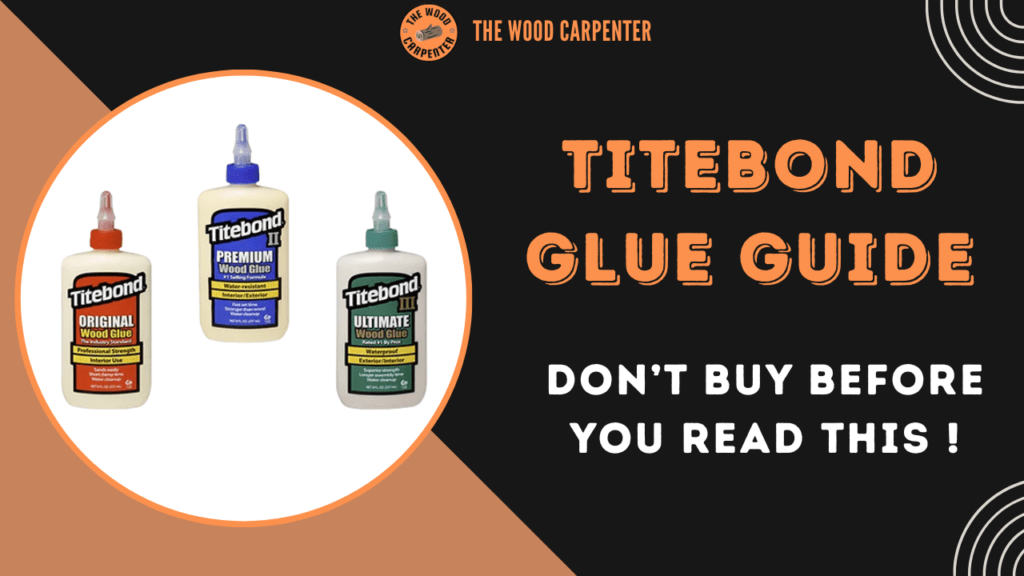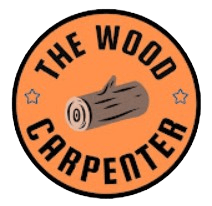
If you’ve ever visited a hardware store or searched for glue online, you’ve probably come across the Titebond brand. But with so many options—like Original, II, III, and more—it can be confusing to choose the right one.
This article will explain the key differences between the top three types: Titebond Original, Titebond II Premium, and Titebond III Ultimate. We’ll go over their features, how they work, and help you decide which one is best for your needs.
What Is Titebond Glue?
Titebond is a well-known brand of wood glue used by carpenters, DIY enthusiasts, and professionals. Most of their glues are made with PVA (polyvinyl acetate), which bonds well to wood and other porous materials.
These glues are strong, dry quickly, and are designed for different uses—such as indoor projects, outdoor work, or even food-safe applications.
Overview: The Big Three Glues
| Type | Best For | Water Resistance | Open Time | Application Temp | Notable Uses |
| Titebond Original | Interior woodworking | None | 4–6 min | 50°F/10°C | Cabinets, furniture, trim |
| Titebond II Premium | Interior & light exterior | Type II (Resistant) | 3–5 min | 55°F/13°C | Cutting boards, outdoor chairs |
| Titebond III Ultimate | Interior & heavy exterior | Type I (Waterproof) | 8–10 min | 47°F/8°C | Decks, planters, kitchenware |
Detailed Breakdown of Titebond Glues
1. Titebond Original
Best For: Indoor use only—good for cabinets, trim, picture frames, furniture, and veneers.

Key Features:
- Strong and fast-setting.
- Easy to clean with water.
- Not water-resistant—don’t use it outside or in damp areas.
- Sands easily and doesn’t affect finishes.
Working Time: You have 4–6 minutes to join the parts. Can remove clamps after 30 minutes (for simple joints).
Strength: Stronger than most woods—the wood usually breaks before the glue does.
Cost: Most affordable option.
2. Titebond II Premium
Best For: Indoor and light outdoor use—good for kitchens, bathrooms, or humid areas (but not for soaking in water).

Key Features:
- Water-resistant (meets Type II standards)—handles splashes and humidity.
- Food-safe for indirect contact—like on cutting boards.
- Sands well and works with finishes.
- Sets a bit faster than Original.
Working Time: 3–5 minutes.
Best Temperature to Use: 55°F (13°C) or warmer.
Cost: Mid-range—more than Original, less than III.
3. Titebond III Ultimate
Best For: Indoor and full outdoor use—perfect for places with rain, snow, or kitchen/bath use.

Key Features:
- Fully waterproof (Type I standard).
- Works in colder temperatures (down to 47°F / 8°C).
- Longer open time—8–10 minutes—great for big or complex projects.
- Food-safe for indirect contact—great for wooden kitchen items.
- Dries slightly darker (tan/brown)—may show on light-colored woods.
Strength: Stronger than II, but in most cases, the wood still breaks before the glue.
Cost: Most expensive, but very versatile—works for almost any project.
4. Other Titebond Glues
Titebond Extend: Like Original, but gives you more working time—good for complex assemblies.
Titebond Liquid Hide: Made from animal glue—sets slowly and can be undone with heat or moisture. Great for old furniture or musical instruments.
Titebond Quick & Thick: Thick glue that dries fast—best for crafts and delicate materials.
Titebond II Dark: Same as Titebond II but dries dark brown—blends better with darker woods.
Specialty & Construction Glues: Designed for plastics, laminates, or projects that need longer working times or different bonding needs.
Key Differences Made Simple
Water Resistance:
Original – Only for dry, indoor use.
Titebond II – Can handle splashes and humidity (Type II).
Titebond III – Fully waterproof (Type I).
Working Time:
III – Longest time to adjust and assemble pieces (best for big or complex projects).
II – Shortest working time (good for quick jobs).
Temperature Use:
III works in cooler temperatures (as low as 47°F), better than Original or II.
Food Safety:
II and III are food-safe for indirect contact (like cutting boards).
Original is not food-safe.
Dry Color:
III dries tan/brown, which may show on light wood.
Original and II dry lighter.
Price:
Original is the cheapest,
II is mid-range,
III is the most expensive.
How to Choose the Right Titebond Glue
For regular indoor projects:
Use Titebond Original – affordable and strong enough.
For light outdoor use or cutting boards:
Go with Titebond II Premium – water-resistant and food-safe.
For full outdoor use, wet areas, or tricky glue-ups:
Pick Titebond III Ultimate – waterproof, longer working time, works in cold.
For cold shops or slow projects:
Titebond III gives you more time to work and bonds well even in lower temps.
Also read:
Mineral Spirits vs Paint Thinner: What’s the Difference?
What All Titebond Glues Have in Common
- Clean up easily with water (before they dry).
- Stronger than the wood itself when used right.
- Sand easily and don’t mess up finishes.
- Safe and non-toxic.
- (II and III are food-safe for indirect contact.)
- Set quickly, so you can remove clamps sooner and save time.
Useful Tips
- Don’t overspend:
- For basic indoor furniture, Original is enough—no need to pay more for III.
- Big or slow builds:
- Use III for more time to work, or when you’re not sure if water will be a problem.
Glue marks:
- III dries darker—so sand well if you want glue lines to be invisible on light woods.
Storage tip:
Don’t let the glue freeze—it can get thick and lumpy. If it does, shake it well and check if it still works.
Titebond Glues at a Glance
| Property | Titebond Original | Titebond II Premium | Titebond III Ultimate |
| Water Resistance | None | Resistant (Type II) | Waterproof (Type I) |
| Open/Working Time | 4–6 min | 3–5 min | 8–10 min |
| Minimum Application Temp | 50°F (10°C) | 55°F (13°C) | 47°F (8°C) |
| Food Safe (Indirect) | No | Yes | Yes |
| Color When Dry | Yellow | Light yellow | Tan/brown |
| Suitable For | Indoor only | Indoors/Light outdoors | Indoors/Full outdoors |
| Strength | Strong | Very strong | Very strong (marginal) |
| Best For | Furniture, joinery | Cutting boards, chairs | Decks, garden, kitchen |
Also read:
Shellac Finish: Do This for Perfect Wood finish !
Stain vs. Varnish: Which Should You Use?
Frequently Asked Questions (FAQs)
1. Is Titebond III stronger than II or Original ?
All three are very strong—stronger than the wood itself. Titebond III is slightly stronger, but usually the wood breaks before the glue does.
2. Can I use Titebond II or III for cutting boards and food-related items ?
Yes! Both are safe for indirect food contact—great for cutting boards, salad bowls, and similar items.
3. What’s the difference between waterproof (Type I) and water-resistant (Type II) ?
Type II (Titebond II): Handles splashes, humidity, and light rain—but not soaking.
Type I (Titebond III): Stronger water protection. Can handle heavy moisture, but not meant for underwater use.
4. Can I use Titebond glue outdoors ?
Yes, but only Titebond II and III.
Use Titebond III for full outdoor exposure (like outdoor furniture).
Use Titebond II for light outdoor use (like birdhouses or picnic tables).
5. I need more time to assemble my project. Which glue is best ?
Titebond III gives you about twice the working time of the other two.
For even more time, try Titebond Extend.
6. Why did my glue joint turn white ?
This happens when glue is used in cold temperatures. Always glue when the room and materials are above the glue’s minimum temperature (usually on the bottle).
7. Is Titebond glue safe and non-toxic ?
Yes, all Titebond glues are non-toxic and safe to use.
Titebond II and III are even safe for indirect food contact.
8. Can Titebond glue be undone or reversed ?
Original, II, and III make permanent bonds.
Titebond Liquid Hide Glue can be reversed with heat or moisture—great for antique or instrument repairs.
9. What happens if Titebond glue freezes ?
Freezing can make the glue thicker.
Most types can survive a few freeze-thaw cycles. Shake or stir it well before using, and check the label for instructions.
10. Can Titebond be used on oily woods like teak ?
It’s tricky, but possible. For best results:
- Lightly sand the surface,
- Wipe with acetone,
- Then apply glue.
Quick Recap:
Titebond Original – Great for indoor projects.
Titebond II – Ideal for indoor/outdoor and food-safe projects.
Titebond III – Best for heavy-duty outdoor use and long glue-ups.
All Titebond glues are strong, easy to use, and trusted by woodworkers everywhere.
Disclaimer: As an Amazon Associate, I earn from qualifying purchases. This means if you click on certain links and make a purchase, I may receive a small commission at no additional cost to you. These commissions help support the content I provide on this site. I only recommend products I truly believe in and that I think will bring value to my readers.

